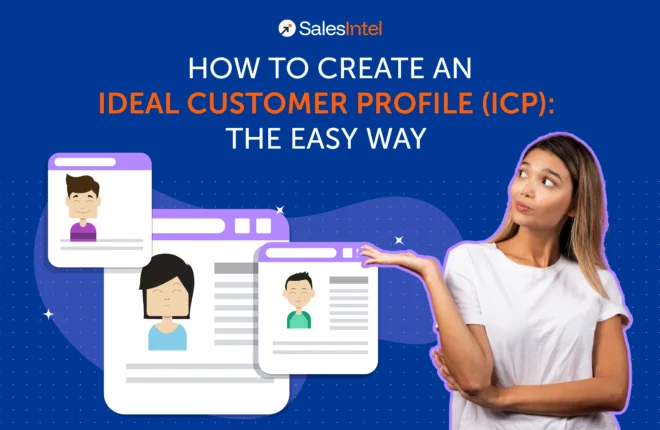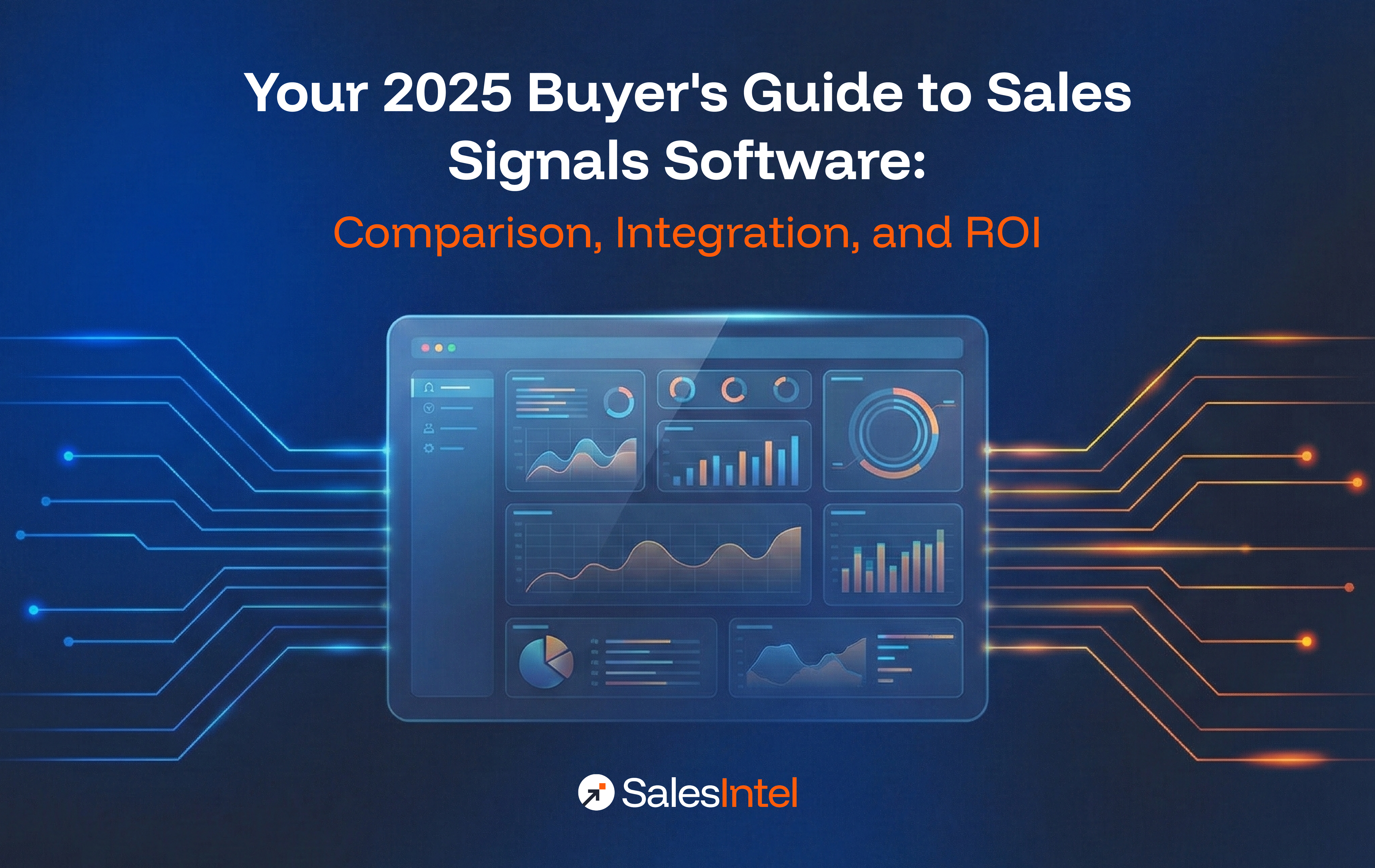Ever feel like your sales team is throwing darts in the dark, hoping to hit a bullseye? Or perhaps your marketing messages resonate with some people, but not consistently with the right people? If so, you’re not alone. Many businesses, even successful ones, operate without a crystal-clear understanding of their Ideal Customer Profile (ICP). And let me tell you, that’s like trying to find a needle in a haystack… blindfolded.
But what if you could shine a spotlight directly on that needle? What if you knew exactly who your best customers are, why they chose you, and what makes them tick? That’s the superpower of an ICP.
A HubSpot research found that companies with a clearly defined Ideal Customer Profile achieve a 68% higher win rate on their sales opportunities compared to those without one. That staggering statistic from a recent HubSpot report isn’t just a number; it’s a testament to the transformative power of focus and precision in sales and marketing. In a world saturated with noise, identifying your perfect customer isn’t just an advantage; it’s a necessity.
So, let’s unlock the secret to finding your perfect match, the easy way. And don’t worry, we’ll even give you a handy template to get started!
What Exactly is an Ideal Customer Profile (ICP)?
Before we dive into creation, let’s get our definitions straight. An Ideal Customer Profile (ICP) is a hypothetical description of the company that would gain the most value from your product or service and, in turn, provide the most value to your business.
Think of it as the customer equivalent of a soulmate for your business. This isn’t just any customer; it’s the customer who:
- Achieves the greatest success with your solution.
- Sticks around the longest (high retention).
- Is most likely to advocate for your brand (referrals!).
- Costs the least to acquire and serve.
- Generates the most revenue and profit over their lifetime.
ICP vs. Buyer Persona: What’s the Difference? (And why it matters!)
This is a common point of confusion, but it’s crucial to understand the distinction:
- ICP (Ideal Customer Profile) focuses on the company. It describes the characteristics of the organization that is a perfect fit for your offering. Think demographics for businesses (firmographics, technographics).
- Buyer Persona focuses on the individual within that company. It describes the specific person or people you need to engage with to make a sale within your ICP company. It delves into their job role, responsibilities, pain points, motivations, and daily challenges.
You need both! First, you identify the right company (ICP), and then you identify the right people within that company (Buyer Personas) to talk to. Without an ICP, you might be talking to the right person… at the wrong company. Awkward!
Why an ICP is Your Sales & Marketing GPS
Creating an ICP isn’t just a fun exercise; it’s a strategic imperative that acts as a GPS for your entire go-to-market strategy. Here’s why it’s an absolute game-changer:
- Hyper-Focused Prospecting: Stop wasting time on unqualified leads. With an ICP, your sales team knows exactly which companies to target, making their outreach far more efficient and effective. This means higher conversion rates and less “dialing for dollars” into the void.
- Magnetic Marketing: Your marketing efforts become laser-focused. Instead of generic campaigns, you can craft messaging, content, and ad campaigns that directly address the specific pain points and aspirations of your ideal companies. This naturally attracts better-fit leads.
- Increased Win Rates & Shorter Sales Cycles: When you’re selling to companies that truly need and value your solution, deals move faster. Your solution isn’t just a “nice-to-have” but a “must-have,” leading to quicker decisions and more closed deals.
- Higher Customer Lifetime Value (CLTV): Ideal customers are inherently stickier. They achieve greater success with your product, leading to higher satisfaction, better retention rates, and a greater likelihood of upsells and referrals. Happy customers become your best salespeople!
- Optimized Resource Allocation: Your sales and marketing teams can dedicate their precious time and budget to the most promising opportunities, leading to a much better return on investment (ROI).
- Better Product Development: Understanding your ICP provides invaluable feedback for product teams. They can build features and solutions that directly address the needs of your most valuable customers, leading to a more relevant and competitive product.
The Easy Way to Create Your ICP: A Step-by-Step Guide
Ready to stop guessing and start targeting? Here’s a streamlined, data-driven approach to building your Ideal Customer Profile:
Step 1: Look at Your Best Customers (The Data-Driven Starting Point)
This is perhaps the most critical step. Your existing successes hold the keys to your future. Identify your happiest, most profitable, and most successful customers. Who are they?
- High Lifetime Value (LTV): Which customers have stuck with you the longest and generated the most revenue?
- High Product Adoption/Engagement: Who uses your product most extensively and effectively?
- High Satisfaction: Who are your biggest advocates? (Think NPS scores, positive reviews, willingness to give testimonials).
- Low Churn Risk: Which customers seem least likely to leave?
- Cost-Effective to Serve: Which customers require less hand-holding or support?
Gathering this data from your CRM, support tickets, and financial records is paramount. This isn’t about who you want to sell to, but who you actually succeed with. This grounded approach ensures your ICP isn’t just a pipe dream.
Step 2: Identify Key Firmographic & Technographic Data Points
Once you’ve identified your “best fit” customers, start analyzing their common characteristics. This is where the magic of data enrichment comes in handy (and where SalesIntel can be a huge assist!).
- Company Size: What’s their employee count? What’s their annual revenue? Are they small businesses, mid-market, or enterprises?
- Industry & Sector: Are they primarily in SaaS, healthcare, manufacturing, finance, retail, etc.? Be specific.
- Location: Where are they geographically? (Country, state, city, region)
- Growth Stage / Maturity: Are they startups, established companies, or mature enterprises? Are they experiencing rapid growth, stable, or perhaps declining?
- Technology Stack (Technographics): What software and tools do they use? (e.g., specific CRM, marketing automation platform, ERP, cloud provider, cybersecurity tools). Knowing this helps you understand their existing infrastructure and potential integrations.
- Budget & Resources: What’s their typical budget range for solutions like yours? Do they have dedicated teams for certain functions?
Step 3: Analyze Behavioral & Environmental Factors
Beyond the hard data, consider the less tangible but equally important aspects:
- Pain Points & Challenges Solved: What specific problems does your product consistently solve for these ideal customers? What frustrations did they have before you came along? This helps you understand their “why.”
- Goals & Aspirations: What are they trying to achieve? How does your solution help them reach their business objectives?
- Competitive Landscape: What competitors were they using (or considering) before choosing you? What made them switch or choose you over others?
- Decision-Making Process: Who is typically involved in the purchasing decision? What does their internal approval process look like?
- Willingness to Innovate: Are they early adopters, or do they prefer proven, established solutions?
Step 4: Collaborate Across Teams (Don’t Be a Lone Wolf!)
An ICP isn’t just for sales. It’s a company-wide North Star. Bring together representatives from:
- Sales: They’re on the front lines, talking to prospects daily. They know what works and what doesn’t.
- Marketing: They attract leads and craft messaging. They need to know who they’re trying to reach.
- Customer Success/Support: They work with customers post-sale and understand their long-term satisfaction, challenges, and churn risks.
- Product Development: They build the solution. They need to know who they’re building it for.
- Leadership: To ensure alignment with overall business goals.
This collaborative approach ensures buy-in and a holistic understanding of your best customers. Plus, it makes the process more fun and less like homework!
Once you’ve gathered all this invaluable information, it’s time to formalize it. Create a clear, concise document that everyone in the company can understand and reference.
The SalesIntel Ideal Customer Profile (ICP) Template
Company Name: [Your Company’s Name Here]
Date Created/Last Updated: [Date]
I. Core Firmographics
- Industry/Vertical: (e.g., Enterprise SaaS, Healthcare Tech, FinTech, E-commerce Retail, Manufacturing)
- Specific Sub-Industry (if applicable):
- Company Size (Employees): (e.g., 50-200, 201-500, 501-1,000, 1,000+)
- Annual Revenue: (e.g., $5M-$20M, $20M-$100M, $100M-$500M, $500M+)
- Geographic Location: (e.g., North America, EMEA, APAC, Specific States/Cities)
- Growth Stage/Maturity: (e.g., Rapid Growth Startup, Established Mid-Market, Mature Enterprise)
- Ownership Structure: (e.g., Privately Held, Publicly Traded, VC/PE-backed)
II. Technographics
- Key Technologies Used: (List specific software/platforms that indicate a good fit or potential challenge. E.g., Salesforce, HubSpot, Marketo, SAP, AWS, Shopify Plus, etc.)
- Technologies they typically don’t use (and why that’s a good fit):
- Integration Needs: (What systems would your solution need to integrate with?)
III. Behavioral & Environmental Factors
- Primary Pain Points/Challenges Solved: (What specific problems do they experience that your solution alleviates?)
- Example: Inefficient data management, high customer churn, difficulty scaling operations, lack of lead qualification.
- Key Goals/Aspirations: (What are they trying to achieve strategically?)
- Example: Improve sales efficiency by 20%, reduce customer acquisition cost, expand into new markets, enhance data security.
- Willingness to Innovate/Adopt New Tech: (Early adopter, follower, traditionalist?)
- Current Solution/Competitors: (What are they doing now? Who are they currently using? What makes them unhappy with it?)
- Budget & Resources: (Are they typically well-funded for solutions like yours? Is budget a common barrier?)
- Typical Decision-Making Process: (Who are the key roles involved? What’s the typical timeline for a purchase decision?)
- Internal Champions/Sponsors: (Who are the likely internal advocates for a solution like yours?)
IV. Value Exchange – Why They Love Us & We Love Them
- Why they are an Ideal customer for us: (What specific benefits do they derive? Why do they stay?)
- Why we are the Ideal Vendor for them: (What unique value do we provide that perfectly matches their needs?)
- Key Success Metrics: (What does “success” look like for them when using your product?)
Step 6: Iterate and Refine
Your ICP isn’t set in stone. The market changes, your product evolves, and your business goals shift. Regularly review and refine your ICP (quarterly or bi-annually) based on:
- New Customer Data: As you acquire more “ideal” customers, analyze their shared traits.
- Sales Feedback: What are sales reps hearing on the front lines? What works, what doesn’t?
- Customer Success Feedback: Who are the happiest, most successful customers? Who struggles?
- Market Trends: Are there new industries or technologies emerging that align with your solution?
Key Components of a Powerful ICP (The Nitty-Gritty Details)
Let’s dive a little deeper into the types of criteria you should be looking for when building out your ICP:
- Company Size (Employees & Revenue): This is foundational. A startup with 10 employees has vastly different needs and budgets than an enterprise with 10,000.
- Industry & Sector: Specialized solutions often shine brightest in specific industries. Understanding compliance needs, industry-specific pain points, and terminology is key.
- Location: Geographic location can impact regulatory requirements, market readiness, and even cultural nuances in decision-making.
- Growth Stage / Maturity: Is the company rapidly expanding and seeking scalable solutions, or are they established and looking for optimization or cost savings?
- Technology Stack (Technographics): This is a huge indicator of sophistication and compatibility. Knowing they use a particular CRM, for example, tells you they’re already invested in managing customer relationships.
- Pain Points & Challenges Solved: This is the why. What specific problems is your solution uniquely positioned to solve for them? What makes them actively seek a change?
- Budget & Resources: Do they have the financial capacity and internal resources (e.g., dedicated IT staff, change management buy-in) to implement and sustain your solution?
- Decision-Making Process: Who are the key stakeholders involved in a purchase decision? Is it a top-down or bottom-up decision? How many layers of approval are there?
- Competitive Landscape: Are they currently using a competitor? Why might they switch? Or are they entirely new to this type of solution?
Common Pitfalls to Avoid (and How to Sidestep Them)
Even with the best intentions, ICP creation can go sideways. Here are a few common traps:
- Making it Too Broad: An ICP that’s too general (“Any company that needs software!”) is as useless as no ICP at all. Be specific.
- Making it Too Narrow: Don’t limit yourself so much that you miss out on legitimate opportunities. Find the sweet spot.
- Ignoring Bad Customers: While you focus on the best, also briefly analyze your worst customers. What characteristics do they share? This helps you define who to actively avoid.
- Relying on Gut Feeling Only: While intuition plays a role, an ICP must be grounded in data. Don’t let assumptions override facts.
- Creating It in a Silo: As discussed, collaboration is key. An ICP created by one department in isolation will likely be ignored by others.
- Setting It and Forgetting It: Your ICP isn’t a static document. Treat it as a living, breathing guide that needs regular updates.
How SalesIntel Elevates Your ICP Creation (Without Being Pushy!)
You’ve probably noticed that building a strong ICP relies heavily on deep, accurate data. That’s precisely where platforms like SalesIntel come into play, making your ICP creation process significantly easier and more effective.
While this blog is about the how-to of ICPs, it’s worth noting how SalesIntel can provide the critical ingredients for your recipe:
- Rich Firmographic Data: We offer comprehensive company data including employee count, revenue, industry, location, and growth signals. You can quickly filter our database to identify companies that match your ideal firmographic criteria from Step 2.
- Deep Technographic Insights: Our platform tracks the technology stacks of millions of companies. This allows you to easily identify companies using specific software that either complements your solution or indicates a pain point you can solve. No more guessing their tech stack!
- Accurate & Verified Contact Data: Once you’ve identified your ideal companies, SalesIntel provides the human-verified direct dials, mobile numbers, and email addresses for the key decision-makers (your Buyer Personas) within those companies. This ensures your sales team connects with the right people, every time.
- Actionable Buyer Intent Data: By showing you which companies are actively researching topics relevant to your product, SalesIntel helps validate if a company is truly “ideal” right now, based on their active interest. This is a powerful behavioral factor for your ICP.
Using a platform like SalesIntel streamlines the data gathering and validation steps, allowing you to focus more on analysis and strategic application, rather than tedious data collection. It’s like having all the ingredients for your ICP pre-sorted and measured, ready for you to bake the perfect sales strategy.
Final Thoughts: Your Blueprint for Success
Creating an Ideal Customer Profile isn’t just about defining who your best customers are; it’s about building a blueprint for scalable, profitable growth. It aligns your sales, marketing, and product teams, ensures every effort is targeted, and ultimately, helps you close more deals with customers who truly love your product and stick around for the long haul.
So, grab that template, gather your team, and embark on this journey. Your future “ideal” customers are waiting for you to find them!
FAQs
How do you create an Ideal Customer Profile?
Building an ICP starts by analyzing your best customers, identifying shared firmographic and technographic traits, and validating them with behavioral data. SalesIntel’s ICPIntel automates this process, aggregating verified company and intent insights to continuously refine and update your ideal customer list.
What is the difference between an Ideal Customer Profile and a Buyer Persona?
An ICP defines the company that’s a perfect fit for your solution, its size, industry, and tech stack. A Buyer Persona defines the individuals within that company who influence or make the purchase. SalesIntel helps you identify both, ensuring you talk to the right people at the right companies.
Social signals help identify your Ideal Customer Profile by revealing patterns in online behavior. By analyzing company engagement with relevant industry topics, competitor content, or solution-based discussions, SalesIntel helps uncover organizations showing genuine interest or intent. These signals, when combined with firmographic and technographic data, refine ICP accuracy and prioritize high-fit accounts.
What questions should you ask when defining an ICP?
Ask questions that define company characteristics and readiness to buy: What’s their size, industry, tech stack, budget, and growth stage? Who makes purchase decisions? What challenges are they trying to solve? SalesIntel provides this data in one place, making ICP definition faster and evidence-based.
How does ICP improve sales and marketing?
A clear ICP ensures sales and marketing alignment by focusing resources on high-probability accounts. With SalesIntel, teams engage only with qualified prospects, personalize outreach effectively, and reduce wasted spend, leading to higher conversion rates, shorter sales cycles, and stronger ROI.
What are the common problems or pitfalls with B2B personas and ICPs?
Common pitfalls include creating ICPs that are too broad, based on assumptions, or not regularly updated. SalesIntel prevents these by grounding every ICP in verified firmographic, technographic, and intent data keeping your targeting strategy precise, relevant, and dynamic.
How does ICP affect B2B lead conversion?
An accurate ICP boosts lead conversion by ensuring outreach targets only the companies most likely to convert. With SalesIntel, sales teams use verified data to focus on decision-makers at in-market accounts, leading to faster engagement, higher win rates, and stronger pipeline growth.




